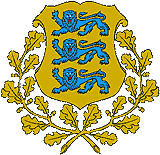| |
 | The Republic of Estonia | | |
National Symbols
State flag
 The state flag, which is also the national flag, is rectangular in shape, divided into three horizontal bands of equal size. The upper band is blue, the middle one is black and the lowest band is white. The proportions of the flag are 11:7 and its normal size is 165x105 cm. The state flag, which is also the national flag, is rectangular in shape, divided into three horizontal bands of equal size. The upper band is blue, the middle one is black and the lowest band is white. The proportions of the flag are 11:7 and its normal size is 165x105 cm.
The blue-black-white flag was first consecrated at Otepää on the 4th of June, 1884, as the flag of the Estonian University Student Association. During the following years the blue-black-white flag became a national symbol.
The Provisional Government of Estonia adopted a resolution on the 21st of November, 1918, proclaiming the blue-black-white flag the state flag. The Law on State Flag was adopted by the Parliament (Riigikogu) on the 27th of June, 1922.After the forcible annexation of Estonia by the Soviet Union in June, 1940, this flag was banned.
In 1987/88, during the days of the "singing revolution", or the process of regaining independence, the blue-black-white flag was used openly as a national symbol. On the 24th of February, 1989, the blue-black-white national flag of Estonia was flown from the tower of Pikk Hermann.
The blue-black-white flag was re-adopted as the state flag on the 7th of August, 1990 and the Law on State Flag was passed on the 6th of April, 1993.
State coat of arms
 The Estonian coat of arms comes in two formats, a large one which shows three blue lions, passant gardant, on a golden shield framed on each side by gilded branch of the oak tree with the stems of the branches crossing at the base of the shield. The small shield is identical except for the gilded branches. The Estonian coat of arms comes in two formats, a large one which shows three blue lions, passant gardant, on a golden shield framed on each side by gilded branch of the oak tree with the stems of the branches crossing at the base of the shield. The small shield is identical except for the gilded branches.
The design of the shield originates from the XII century, when the Danish King Valdemar II presented the City of Tallinn (Reval) with a coat of arms similar to that of the state of Denmark, showing three lions. A similar motif was transposed to the coat of arms of the Province of Estonia, which was adopted by Catherine II, Empress of Russia, on the 4th of October, 1788.
The Parliament (Riigikogu) of the Republic of Estonia adopted the state coat of arms on the 19th of June, 1925. After the forcible annexation of Estonia by the Soviet Union in 1940, this coat of arms was banned.
The use of the historic coat of arms as the state coat of arms of the Republic of Estonia was re-adopted on the 7th of August, 1990. The Law on State Coat of Arms was passed on the 6th of April, 1993.
National anthem
My Native Land, My Joy, Delight Sound file 37 sec. (mp3 - 879KB)
The Estonian national anthem "My Native Land..." is a choral-like melody arranged by a Finnish composer of German origin Fredrik Pacius in 1843. In Estonia, Johann Voldemar Jannsen's lyrics were set to this melody and sung at the first Estonian Song Festival in 1869. It gained in popularity during the growing national movement. In Finland, it first became popular only as a students' song , but soon also became more widely accepted. When both Estonia and Finland became independent after the First World War this identical melody with different words was recognized as the national anthem by both nations. Officially, Estonia adopted it in 1920, after the War of Independence. During the decades of the Soviet occupation of Estonia, the melody was strictly forbidden and people were sent to Siberia for singing it. However, even during the worst years the familiar tune could be heard over Finnish radio, every day at the beginning and end of the program. Thus, the melody could never be forgotten. With the restoration of Estonian independence, the national anthem has, of course, been restored too.
|
| |
|

 vpk.ee
vpk.ee
 vpk.ee
vpk.ee